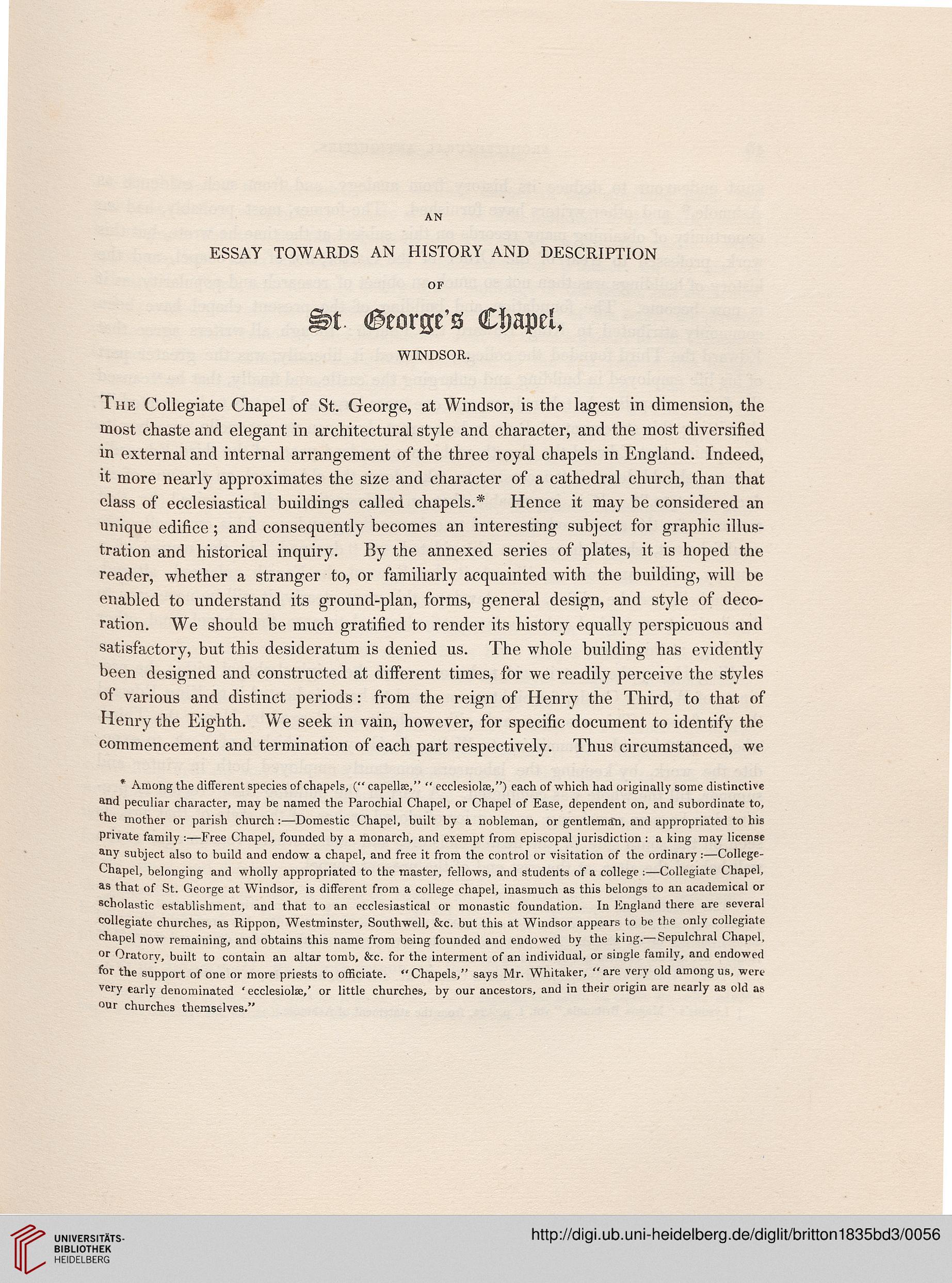an
ESSAY TOWARDS AN HISTORY AND DESCRIPTION
of
g>t George's Cfjapel,
WINDSOR.
The Collegiate Chapel of St. George, at Windsor, is the lagest in dimension, the
most chaste and elegant in architectural style and character, and the most diversified
m external and internal arrangement of the three royal chapels in England. Indeed,
it more nearly approximates the size and character of a cathedral church, than that
class of ecclesiastical buildings called chapels.* Hence it may be considered an
unique edifice ; and consequently becomes an interesting subject for graphic illus-
tration and historical inquiry. By the annexed series of plates, it is hoped the
reader, whether a stranger to, or familiarly acquainted with the building, will be
enabled to understand its ground-plan, forms, general design, and style of deco-
ration. We should be much gratified to render its history equally perspicuous and
satisfactory, but this desideratum is denied us. The whole building has evidently
been designed and constructed at different times, for we readily perceive the styles
of various and distinct periods: from the reign of Henry the Third, to that of
Henry the Eighth. We seek in vain, however, for specific document to identify the
commencement and termination of each part respectively. Thus circumstanced, we
* Among the different species of chapels, (" capella?," " ecclesiolse,") each of which had originally some distinctive
and peculiar character, may be named the Parochial Chapel, or Chapel of Ease, dependent on, and subordinate to,
the mother or parish church:—Domestic Chapel, built by a nobleman, or gentleman, and appropriated to his
private family :—Free Chapel, founded by a monarch, and exempt from episcopal jurisdiction : a king may license
any subject also to build and endow a chapel, and free it from the control or visitation of the ordinary:—College-
Chapel, belonging and wholly appropriated to the master, fellows, and students of a college :—Collegiate Chapel,
as that of St. George at Windsor, is different from a college chapel, inasmuch as this belongs to an academical or
scholastic establishment, and that to an ecclesiastical or monastic foundation. In England there are several
collegiate churches, as Rippon, Westminster, Southwell, &c. but this at Windsor appears to be the only collegiate
chapel now remaining, and obtains this name from being founded and endowed by the king.— Sepulchral Chapel,
or Oratory, built to contain an altar tomb, &c. for the interment of an individual, or single family, and endowed
for the support of one or more priests to officiate. " Chapels," says Mr. Whitaker, " are very old among us, were
very early denominated ' ecclesiola:,' or little churches, by our ancestors, and in their origin are nearly as old as
our churches themselves."
ESSAY TOWARDS AN HISTORY AND DESCRIPTION
of
g>t George's Cfjapel,
WINDSOR.
The Collegiate Chapel of St. George, at Windsor, is the lagest in dimension, the
most chaste and elegant in architectural style and character, and the most diversified
m external and internal arrangement of the three royal chapels in England. Indeed,
it more nearly approximates the size and character of a cathedral church, than that
class of ecclesiastical buildings called chapels.* Hence it may be considered an
unique edifice ; and consequently becomes an interesting subject for graphic illus-
tration and historical inquiry. By the annexed series of plates, it is hoped the
reader, whether a stranger to, or familiarly acquainted with the building, will be
enabled to understand its ground-plan, forms, general design, and style of deco-
ration. We should be much gratified to render its history equally perspicuous and
satisfactory, but this desideratum is denied us. The whole building has evidently
been designed and constructed at different times, for we readily perceive the styles
of various and distinct periods: from the reign of Henry the Third, to that of
Henry the Eighth. We seek in vain, however, for specific document to identify the
commencement and termination of each part respectively. Thus circumstanced, we
* Among the different species of chapels, (" capella?," " ecclesiolse,") each of which had originally some distinctive
and peculiar character, may be named the Parochial Chapel, or Chapel of Ease, dependent on, and subordinate to,
the mother or parish church:—Domestic Chapel, built by a nobleman, or gentleman, and appropriated to his
private family :—Free Chapel, founded by a monarch, and exempt from episcopal jurisdiction : a king may license
any subject also to build and endow a chapel, and free it from the control or visitation of the ordinary:—College-
Chapel, belonging and wholly appropriated to the master, fellows, and students of a college :—Collegiate Chapel,
as that of St. George at Windsor, is different from a college chapel, inasmuch as this belongs to an academical or
scholastic establishment, and that to an ecclesiastical or monastic foundation. In England there are several
collegiate churches, as Rippon, Westminster, Southwell, &c. but this at Windsor appears to be the only collegiate
chapel now remaining, and obtains this name from being founded and endowed by the king.— Sepulchral Chapel,
or Oratory, built to contain an altar tomb, &c. for the interment of an individual, or single family, and endowed
for the support of one or more priests to officiate. " Chapels," says Mr. Whitaker, " are very old among us, were
very early denominated ' ecclesiola:,' or little churches, by our ancestors, and in their origin are nearly as old as
our churches themselves."




